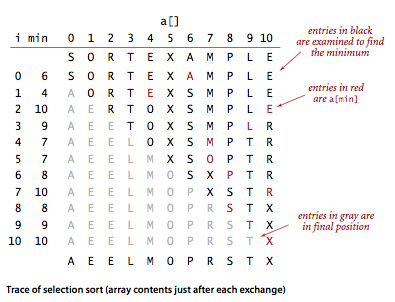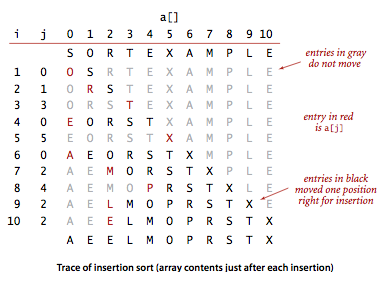介绍
排序就是将一组对象按照某种逻辑顺序重新排列的过程。排序算法的目标是将所有元素的主键按照某种方式排列。在java中,元素通常都是对象,对主键的描述则是通过一种内置的机制—Comparable接口。
排序算法类的模板:
1 | /** |
可比较的数据类型:
java中封装了许多数据类型例:Integer、Double、String、File、URL等都实现了Comparable接口,具有比较方法。在创建自己的数据类型是,我们只要实现Comparable接口就能保证用例代码可以将其排序,再实现一个compareTo方法来定义目标数据类型的自然次序。
1 | /** |
排序的成本模型:
在研究排序算法时,我们需要计算比较和交换的数量,对于不交换元素的算法,我们会计算访问数组的次数。
选择排序
选择排序:先找到数组中最小的那个元素,将它和数组的第一个元素交换位置,然后在剩下的元素中找到最小的元素,将它和数组的第二个元素交换位置,如此反复,直到将整个数组排序。
1 | public static void selectSort(Comparable[] a){ |
说明:
- 运行时间和输入无关。选择排序会一遍遍扫描数组,一个有序数组和无序数组用选择排序时间一样
- 数据移动是最少的。对于长度为N的数组,选择排序需要大约N^2/2次比较和N次交换。交换次数和数组大小是线性关系
- 该算法在第I个元素排好序后,I前面的元素不会再被访问(数组扫描)。
- 算法的时间效率取决于比较的次数。
选择排序的轨迹:

插入排序
插入排序:将每个元素插入到合适的位置,我们需要在插入元素时将其余所有元素向右移动一位。与选择排序一样,当前索引左边的所有元素都是有序的,当索引到达数组的右端时,数组排序就完成了。和选择排序不同的是,插入排序所需要的时间取决于输入中元素的初识位置。
1 | public static void insertSort(Comparable[] a){ |
说明:
- 插入排序对部分有序数组很有效,选择排序则都一样。
- 对于有序数组,插入排序能够立即发现每个元素都已经在合适的位置上,它的运行时间是线性的。
- 对于随机排列的长度为N且主键不重复的数组,平均情况下插入排序需要~N^2/4次比较以及~N^2/4次交换;最坏情况下需要~N^2/2次比较和~N^2/2次交换;最好情况下需要N-1次比较和0次交换。
- 大幅度提高插入排序的速度,只需要在内循环中将较大的元素都向右移动而不总是交换。
插入排序轨迹:

两种排序算法比较
插入排序不会访问索引右侧的元素,选择排序不会访问索引左侧的元素。两种算法的可视轨迹图:

比较两种排序算法
1 | /** |
说明:
对于随机排序的无重复主键的数组,插入排序和选择排序的运行时间是平方级别的,两者之比应该是一个较小的常数。